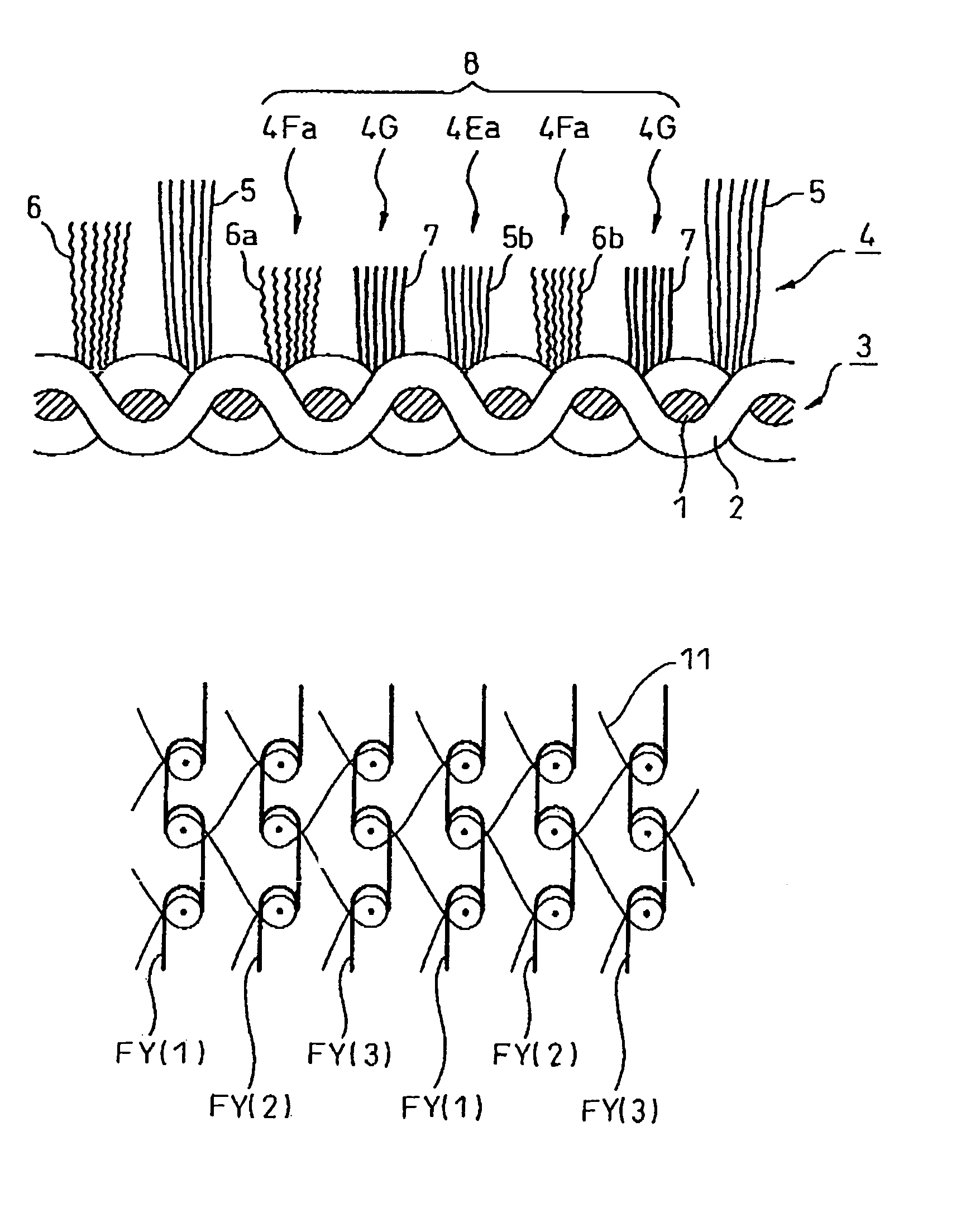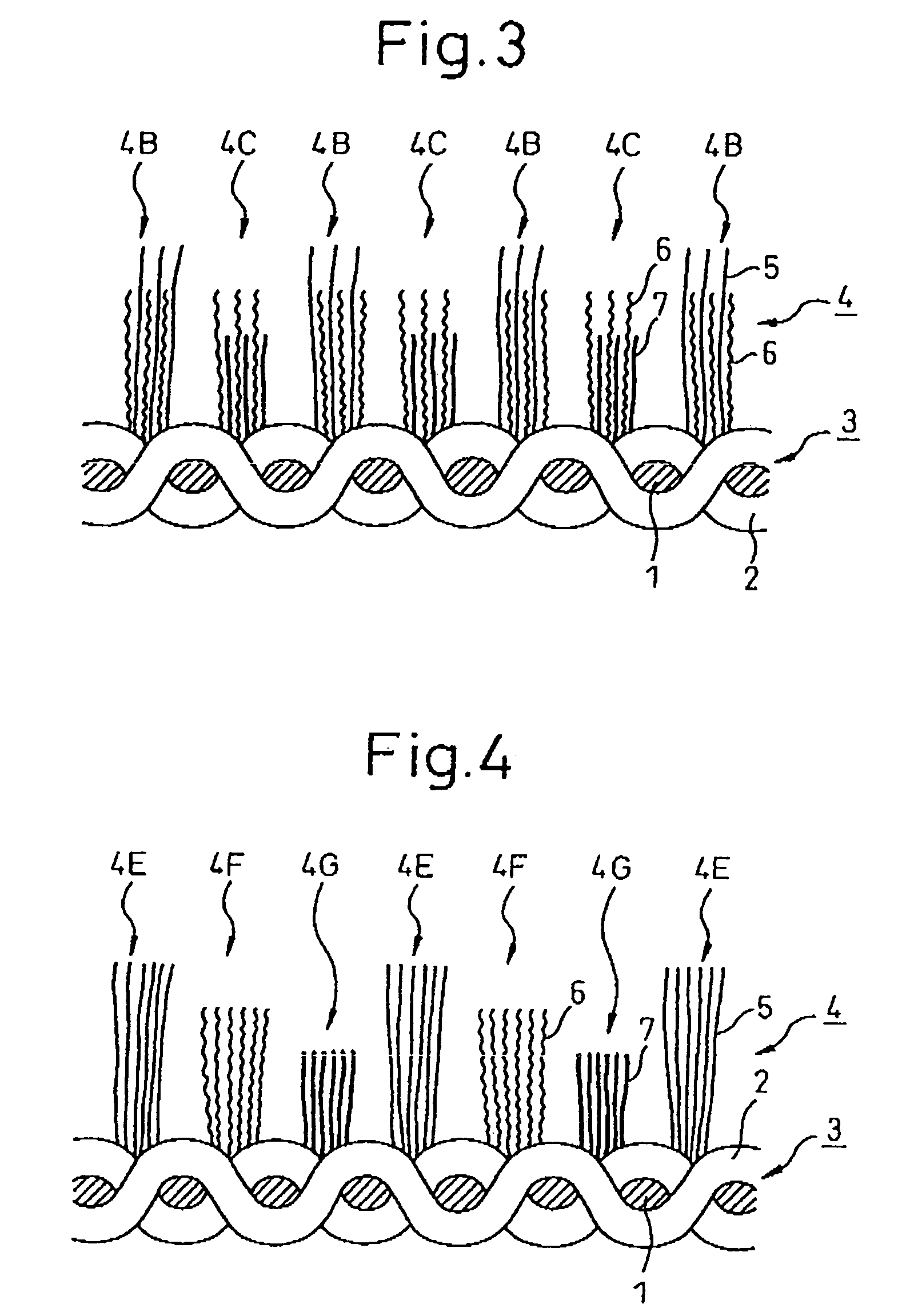Concave and convex-patterned multi-colored fiber pile fabric
a multi-colored pile fabric, concave and convex technology, applied in the direction of flat warp knitting machines, dyeing process, knitting, etc., can solve the problems of insufficient realization of concave-and-convex-patterns
- Summary
- Abstract
- Description
- Claims
- Application Information
AI Technical Summary
Benefits of technology
Problems solved by technology
Method used
Image
Examples
example 1
[0104]A polyethylene terephthalate multifilament yarn (yarn count: 84 dtex / 36 filaments) was heat-treated under treating conditions, namely a heater length of 2 m, a heat treatment temperature of 200° C., a heat-treatment speed of 500 m / min. and a overfeed percentage of 5%.
[0105]The resultant non-crimped polyester filament yarn (1) exhibited a shrinkage in boiling water of 1.2%.
[0106]Separately, a cationic dye-dyeable polyester was produced in such a manner that, in the production of polyethylene terephthalate by a polycondensation procedure, the acid component contained sodium sulfoisophthalic acid in an amount of 2.6 molar %, based on the total molar amount of the acid component, to copolymerize the cationic compound into the polyethylene terephthalate. From the resultant cationic dye-dyeable polyester, a crimped polyester filament yarn (2) having a yarn count of 100 dtex / 24 filaments, and a crimp percentage of 21% realized by a false-twisting procedure, was produced.
[0107]Further...
example 2
[0125]A concave-and convex-patterned multi-colored fiber pile fabric was produced by the same procedures as in Example 1 with the following exceptions.
[0126]As filament yarns for forming the non-crimped pile fibers (1), non-crimped polyester (polyethylene terephthalate) filaments (1) formed from a resin colored with a black-coloring pigment and having a yarn count of. 75 dtex / 36 yarns were employed. The filaments (1) exhibited a shrinkage in water of 1.2%.
[0127]Also, in the dyeing procedure, the dyeing both contained no Teratop Pink 2GLA and no Teratop Blue HLB. Thus, in the cut pile layer, the crimped cationic dye-dyeable polyester filaments (2) were dyed in a brown color and the dyed color was different in hue and lightness from the black color of the non-crimped polyester filaments (1). Further, the non-crimped copolyester filaments (3) were not colored by the dyeing procedure.
[0128]In the chemically etched cut pile fabric, a concave-and convex-pattern was formed from large depth...
example 3
[0130]A concave-and convex-patterned multi-colored fiber pile fabric was produced by the same manner as in Example 1, with the following exceptions.
[0131]Three types of pile-forming filament yarns (1), (2) and (3) each having a total thickness of 284 dtex were respectively prepared from the polyester (PET) filaments (1) for the non-crimped pile fibers (1), the cationic dye-dyeable polyester filaments (2) for the crimped pile fibers (2) and non-crimped copolyester filaments (3) for the non-crimped pile fibers (3).
[0132]The filament yarns (1), (2) and (3) for forming the pile layer and the same polyester filament yarn as in Example 1 for forming the ground structure portion were subjected to a knitting procedure in the knitting structure shown in FIG. 8, to produce a pile fabric. In the resultant pile fabric, a combination of a light purplish red-colored pile ridge consisting of non-crimped polyester pile fibers (1) and having a highest pile height and a high lightness; a brown-colore...
PUM
| Property | Measurement | Unit |
|---|---|---|
| mass ratio | aaaaa | aaaaa |
| mass ratio | aaaaa | aaaaa |
| shrinkage | aaaaa | aaaaa |
Abstract
Description
Claims
Application Information
 Login to View More
Login to View More - R&D
- Intellectual Property
- Life Sciences
- Materials
- Tech Scout
- Unparalleled Data Quality
- Higher Quality Content
- 60% Fewer Hallucinations
Browse by: Latest US Patents, China's latest patents, Technical Efficacy Thesaurus, Application Domain, Technology Topic, Popular Technical Reports.
© 2025 PatSnap. All rights reserved.Legal|Privacy policy|Modern Slavery Act Transparency Statement|Sitemap|About US| Contact US: help@patsnap.com



